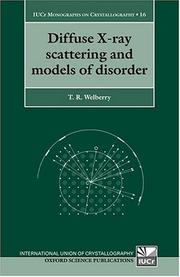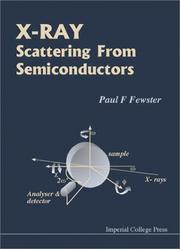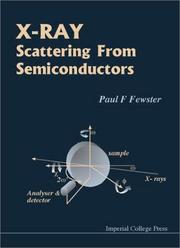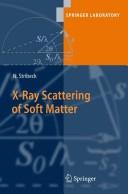
ISBN: 1280847042 0191523763 9780191523762 9786610847044 6610847045 9780198528586 0198528582 0198528582 Year: 2004 Publisher: Oxford Oxford University Press
Abstract | Keywords | Export | Availability | Bookmark
 Loading...
Loading...Choose an application
- Reference Manager
- EndNote
- RefWorks (Direct export to RefWorks)
Diffuse X-ray scattering is a rich (virtually untapped) source of local structural information over and above that obtained by conventional crystallography. The book aims to show how computer simulation of a model crystal provides a general method by which diffuse scattering of all kinds and from all types of materials can be interpreted and analysed. - ;Diffuse X-ray scattering is a rich (virtually untapped) source of local structural information over and above that obtained by conventional crystal structure determination (crystallography). The main aim in the book is to show how computer
X-rays --- X-ray crystallography. --- Crystallography --- X-ray scattering --- Scattering (Physics) --- Scattering. --- Physicochemistry --- Chemical and physical crystallography

ISBN: 1628702311 1281866369 9786611866365 1860944582 9781860944581 1860943608 9781860943607 Year: 2003 Publisher: London Imperial College Press
Abstract | Keywords | Export | Availability | Bookmark
 Loading...
Loading...Choose an application
- Reference Manager
- EndNote
- RefWorks (Direct export to RefWorks)
This book presents a practical guide to the analysis of materials and includes a thorough description of the underlying theories and instrumental aberrations caused by real experiments. The main emphasis concerns the analysis of thin films and multilayers, primarily semiconductors, although the techniques are very general. Semiconductors can be very perfect composite crystals and therefore their study can lead to the largest volume of information, since X-ray scattering can assess the deviation from perfection.
X-rays --- Semiconductors. --- Crystalline semiconductors --- Semi-conductors --- Semiconducting materials --- Semiconductor devices --- Crystals --- Electrical engineering --- Electronics --- Solid state electronics --- X-ray scattering --- Scattering (Physics) --- Scattering. --- Materials
Book
ISBN: 9781624175060 1624175066 161324326X 9781613243268 Year: 2012 Publisher: New York
Abstract | Keywords | Export | Availability | Bookmark
 Loading...
Loading...Choose an application
- Reference Manager
- EndNote
- RefWorks (Direct export to RefWorks)
Radiography, Industrial. --- X-rays --- X-ray scattering --- Scattering (Physics) --- Industrial radiography --- Materials --- Radiographic examination of materials --- Radiology, Industrial --- Gamma rays --- Nondestructive testing --- Radioisotopes --- Scattering. --- Radiography --- Industrial applications
Book
ISBN: 9780199228676 9780199228683 019922868X 0199228671 0191775118 0191004774 9780191004773 1299617069 9781299617063 Year: 2011 Publisher: Oxford University Press
Abstract | Keywords | Export | Availability | Bookmark
 Loading...
Loading...Choose an application
- Reference Manager
- EndNote
- RefWorks (Direct export to RefWorks)
The opportunities for doing scattering experiments at synchrotron and neutron facilities have grown rapidly in recent years and are set to continue to do so into the foreseeable future. This text provides a basic understanding of how these techniques enable the structure and dynamics of materials to be studied at the atomic and molecular level. Although mathematics cannot be avoided in a theoretical discussion, the aim has been to write a book that most scientists will still findapproachable. To this end, the first two chapters are devoted to providing a tutorial background in the mathematics
Neutrons --- X-rays --- Scattering. --- Rayons X --- Scattering --- Diffusion --- X-ray scattering --- Scattering (Physics) --- Nucleon-nucleon scattering --- Potential scattering --- scattering experiments, synchrotron facilities, neutron facilities, dynamics of materials, structure of materials
Book
ISBN: 3038972851 3038972843 Year: 2019 Publisher: MDPI - Multidisciplinary Digital Publishing Institute
Abstract | Keywords | Export | Availability | Bookmark
 Loading...
Loading...Choose an application
- Reference Manager
- EndNote
- RefWorks (Direct export to RefWorks)
The intent of this Special Issue is to provide a framework with which scientists in several different disciplines, related to phase-contrast and dark-field imaging, can illustrate their ideas and results. The articles are reviews or very recent scientific reports; they address newcomers in the field, as well as experts and professors in fields of X-ray physics, electron, and phase-contrast X-ray imaging.
X-ray scattering --- Coded-aperture imaging --- Talbot-Interferometer --- Moiré pattern analysis --- Electron Backscatter imaging --- Dark-field imaging --- Computed Tomography --- cultural heritage --- X-ray Phase-contrast imaging --- medical imaging --- image processing: Fourier image analysis

ISBN: 184816047X 9781848160477 1860941591 9781860941597 Year: 2000 Publisher: London Imperial College Press
Abstract | Keywords | Export | Availability | Bookmark
 Loading...
Loading...Choose an application
- Reference Manager
- EndNote
- RefWorks (Direct export to RefWorks)
This study provides a thorough description of the techniques involved in obtaining information about materials, including X-ray diffractometers and their associated instrument functions, data collection methods and the simulation of the patterns.
Semiconductors. --- X-rays --- X-ray scattering --- Scattering (Physics) --- Crystalline semiconductors --- Semi-conductors --- Semiconducting materials --- Semiconductor devices --- Crystals --- Electrical engineering --- Electronics --- Solid state electronics --- Scattering. --- Materials --- Electronics and optics of solids
Book
ISBN: 3030646238 303064622X Year: 2021 Publisher: Springer Nature
Abstract | Keywords | Export | Availability | Bookmark
 Loading...
Loading...Choose an application
- Reference Manager
- EndNote
- RefWorks (Direct export to RefWorks)
This open access book collects the contributions of the seventh school on Magnetism and Synchrotron Radiation held in Mittelwihr, France, from 7 to 12 October 2018. It starts with an introduction to the physics of modern X-ray sources followed by a general overview of magnetism. Next, light / matter interaction in the X-ray range is covered with emphasis on different types of angular dependence of X-ray absorption spectroscopy and scattering. In the end, two domains where synchrotron radiation-based techniques led to new insights in condensed matter physics, namely spintronics and superconductivity, are discussed. The book is intended for advanced students and researchers to get acquaintance with the basic knowledge of X-ray light sources and to step into synchrotron-based techniques for magnetic studies in condensed matter physics or chemistry.
Spectrum analysis, spectrochemistry, mass spectrometry --- Atomic & molecular physics --- Optical physics --- Fluid mechanics --- Circuits & components --- Spectroscopy and Microscopy --- Atomic, Molecular, Optical and Plasma Physics --- Optics, Lasers, Photonics, Optical Devices --- Condensed Matter Physics --- Magnetism, Magnetic Materials --- Semiconductors --- X-Ray Spectroscopy --- Synchrotron Techniques --- Laser-Matter Interaction --- Strongly Correlated Systems --- Magnetism --- x-ray light sources --- x-ray scattering --- spintronics --- Open Access --- Gauge invariance in spectroscopy --- molecular magnestism --- magnetic semiconductors --- Scientific equipment, experiments & techniques --- Applied optics --- Materials / States of matter --- Electricity, electromagnetism & magnetism --- Electronic devices & materials
Book
ISBN: 3319070703 331907069X Year: 2014 Publisher: Cham : Springer International Publishing : Imprint: Springer,
Abstract | Keywords | Export | Availability | Bookmark
 Loading...
Loading...Choose an application
- Reference Manager
- EndNote
- RefWorks (Direct export to RefWorks)
This thesis presents the results of resonant and non-resonant x-ray scattering experiments demonstrating the control of collective ordering phenomena in epitaxial nickel-oxide and copper-oxide based superlattices. Three outstanding results are reported: (1) LaNiO3-LaAlO3 superlattices with fewer than three consecutive NiO2 layers exhibit a novel spiral spin density wave, whereas superlattices with thicker nickel-oxide layer stacks remain paramagnetic. The magnetic transition is thus determined by the dimensionality of the electron system. The polarization plane of the spin density wave can be tuned by epitaxial strain and spatial confinement of the conduction electrons. (2) Further experiments on the same system revealed an unusual structural phase transition controlled by the overall thickness of the superlattices. The transition between uniform and twin-domain states is confined to the nickelate layers and leaves the aluminate layers unaffected. (3) Superlattices based on the high-temperature superconductor YBa2Cu3O7 exhibit an incommensurate charge density wave order that is stabilized by heterointerfaces. These results suggest that interfaces can serve as a powerful tool to manipulate the interplay between spin order, charge order, and superconductivity in cuprates and other transition metal oxides.
Transition metal oxides. --- X-rays --- Scattering. --- X-ray scattering --- Scattering (Physics) --- Metallic oxides --- Transition metal compounds --- Optical materials. --- Strongly Correlated Systems, Superconductivity. --- Spectroscopy and Microscopy. --- Optical and Electronic Materials. --- Optics --- Materials --- Superconductivity. --- Superconductors. --- Spectroscopy. --- Microscopy. --- Electronic materials. --- Electronic materials --- Analysis, Microscopic --- Light microscopy --- Micrographic analysis --- Microscope and microscopy --- Microscopic analysis --- Optical microscopy --- Analysis, Spectrum --- Spectra --- Spectrochemical analysis --- Spectrochemistry --- Spectrometry --- Spectroscopy --- Chemistry, Analytic --- Interferometry --- Radiation --- Wave-motion, Theory of --- Absorption spectra --- Light --- Spectroscope --- Superconducting materials --- Superconductive devices --- Cryoelectronics --- Electronics --- Solid state electronics --- Electric conductivity --- Critical currents --- Superfluidity --- Qualitative --- Analytical chemistry

ISBN: 9783540698555 3540698558 9786610863792 3540698566 128086379X Year: 2007 Publisher: Berlin ; New York : Springer,
Abstract | Keywords | Export | Availability | Bookmark
 Loading...
Loading...Choose an application
- Reference Manager
- EndNote
- RefWorks (Direct export to RefWorks)
Applications of X-ray scattering to soft matter have advanced considerably within recent years, both conceptually and technically – mature high-power X-ray sources, synchrotrons and rotating anodes, as well as high-speed detectors have become readily available. High-quality time-resolved experiments on polymer structure now can be performed with ease, a major advancement due to the genuine power of the scattering method. This manual summarizes the analytical power of modern X-ray scattering in the field of soft matter. Description of simple tools that can elucidate the mechanisms of structure evolution in the studied materials is followed by a step-by-step guide and breakdown of the more advanced methods. Data analysis based on clear, unequivocal results is rendered simple and straightforward – with a stress on the carefully planning of the experiments and adequate recording of all required data. To this end, this book serves as a useful ready-reference guide.
Soft condensed matter --- X-rays --- Matière molle (Physique) --- Rayons X --- Scattering --- Diffusion --- Soft condensed matter. --- Organic Chemistry --- Atomic Physics --- Physics --- Chemistry --- Physical Sciences & Mathematics --- Scattering. --- Matière molle (Physique) --- EPUB-LIV-FT LIVCHIMI SPRINGER-B --- X-ray scattering --- Chemistry. --- Physical chemistry. --- Polymers. --- Condensed matter. --- Amorphous substances. --- Complex fluids. --- Materials science. --- Polymer Sciences. --- Condensed Matter Physics. --- Characterization and Evaluation of Materials. --- Soft and Granular Matter, Complex Fluids and Microfluidics. --- Physical Chemistry. --- Scattering (Physics) --- Condensed matter --- Matter, Soft (Condensed matter) --- Matter, Soft condensed --- Soft matter (Condensed matter) --- Complex fluids
Book
ISBN: 3540885870 3540885889 Year: 2009 Publisher: Berlin : Springer,
Abstract | Keywords | Export | Availability | Bookmark
 Loading...
Loading...Choose an application
- Reference Manager
- EndNote
- RefWorks (Direct export to RefWorks)
This book is the first comprehensive introduction to X-ray and neutron reflectivity techniques and illustrates them with many examples. After a pedagogical introduction on the interaction of X-rays and neutrons with matter, the interplay between the statistics of rough surfaces and interfaces and the scattering of radiation is considered in detail. Specular reflectivity and diffuse scattering are discussed next , in chapters 3 and 4 . The approximations are rigorously introduced and many experimental effects are discussed. The specific aspects of neutron reflectivity require separate treatment, given in chapter 5. Chapter 6 turns to X-ray reflectivity by rough multilayers. Eventually, chapter 7 introduces and discusses the by now well-established method of grazing incidence small angle X-ray scattering to investigate nanostructures. For the second edition, the material has been completely reorganized so as to meet the demand for a modern multi-author textbook for PhD students and young researchers. All chapters have further been thoroughly revised, updated and, where appropriate, suitably augmented. The first edition was been published as Lect. Notes Phys. m58 in the same series.
X-rays --- Neutrons --- Atomic Physics --- Light & Optics --- Physics --- Physical Sciences & Mathematics --- Scattering --- Scattering. --- X-ray scattering --- Physics. --- Solid state physics. --- Spectroscopy. --- Microscopy. --- Materials science. --- Materials --- Thin films. --- Solid State Physics. --- Spectroscopy and Microscopy. --- Surfaces and Interfaces, Thin Films. --- Characterization and Evaluation of Materials. --- Surfaces. --- Nucleon-nucleon scattering --- Potential scattering --- Scattering (Physics) --- Surfaces (Physics). --- Surface chemistry --- Surfaces (Technology) --- Materials—Surfaces. --- Material science --- Physical sciences --- Films, Thin --- Solid film --- Solid state electronics --- Solids --- Coatings --- Thick films --- Analysis, Microscopic --- Light microscopy --- Micrographic analysis --- Microscope and microscopy --- Microscopic analysis --- Optical microscopy --- Optics --- Analysis, Spectrum --- Spectra --- Spectrochemical analysis --- Spectrochemistry --- Spectrometry --- Spectroscopy --- Chemistry, Analytic --- Interferometry --- Radiation --- Wave-motion, Theory of --- Absorption spectra --- Light --- Spectroscope --- Qualitative --- Analytical chemistry

 Search
Search Feedback
Feedback About UniCat
About UniCat  Help
Help News
News